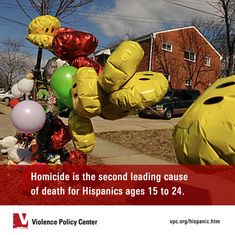One of the sad realities of gun violence in America is that some groups of people bear the brunt of this epidemic more than others. One of these groups is Hispanics. New research by my organization, the Violence Policy Center, finds that fatal gun violence has a disproportionate impact on the Hispanic community.
Our study, Hispanic Victims of Lethal Firearms Violence in the United States, is now in its second year. It is based on the most recent available data from the federal Centers for Disease Control and Prevention (CDC) as well as the Federal Bureau of Investigation's (FBI) Supplementary Homicide Report. The report is available in English and Spanish.
And the statistics are sobering. More than 47,000 Hispanics were killed with guns in the United States between 1999 and 2013, with an average of more than 3,000 gun deaths per year. Approximately two thirds of the gun deaths were homicides (31,800, or 67 percent), while 13,317 were suicides (28 percent).
We also found the overall homicide victimization rate for Hispanics is nearly double the homicide victimization rate for whites. For Hispanics, the homicide victimization rate in 2013, the most recent year for which data is available, was 4.75 per 100,000. That year, the homicide victimization rate for whites was 2.50 per 100,000.
Guns were used in more than two-thirds of the homicides where the victims were Hispanic. Seventy-two percent of Hispanic gun homicide victims were killed with a handgun.
These are eye-opening facts about a significant portion of our citizenry that are all too often neglected in our national awareness about gun violence. Yet at the same time, we found there are major gaps in the data. Government agencies often report information on race, but not on ethnic origin. Because of these limitations in the way data is collected, the total number of Hispanic victims is almost certainly higher than the reported numbers suggest.
That's why we are recommending that government agencies improve their collection and reporting of data on Hispanic victims of gun violence and other lethal violence, so that policymakers can better understand this problem and take long-overdue steps to address it.
Additional findings of the study include:
•In 2013, the most recent year for which data is available, 2,951 Hispanics were killed with guns. That year, 1,750 Hispanics died in gun homicides, 1,034 died in gun suicides, 49 died in unintentional shootings, and 118 died in other circumstances, including legal intervention and undetermined intent.
•Homicide is the second leading cause of death for Hispanics ages 15 to 24. For whites in that age group, homicide is the fourth-leading cause of death, and for blacks it is the leading cause of death.
•A large percentage of Hispanic homicide victims are young. According to the most recent available data, 37 percent of Hispanic victims in 2012 were age 24 and younger. In comparison, 38 percent of black homicide victims and 21 percent of white homicide victims were age 24 and younger that year.
•Hispanic victims are more likely to be killed by a stranger than the national average. The latest FBI Supplementary Homicide Report data from 2012 shows that when the victim-to-offender relationship could be identified, 36 percent of Hispanic homicide victims were killed by a stranger. Nationwide, 26 percent of all homicide victims were killed by strangers.
Across the nation, community leaders are already working tirelessly to stop gun violence in the Hispanic community. These people deserve our continued recognition and support. However, we also learned from our study that we don't have nearly enough data to obtain a complete picture of the problem. That's why government agencies urgently need to improve their collection of information about gun violence among Hispanics. Fully understanding the scope of this crisis is the first step toward ending it.

